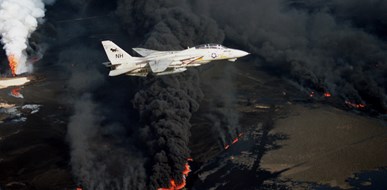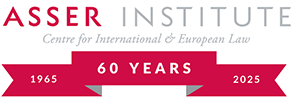[Publication] Uneven progress in environmental protection in armed conflicts
Published 6 November 2023
A U.S. Navy Grumman F-14A Tomcat from Fighter Squadron 114 (VF-114) Aardvarks flies over an oil well set ablaze by Iraqi troops during the 1991 Gulf War. Lt. Steve Gozzo (C) U.S. Navy - Public Domain.
In a recent book chapter in the Netherlands Yearbook of International Law, Stavros-Evdokimos Pantazopoulos explores the increased consideration of the environment and environmental law in armed conflicts. He concludes that, while there has been significant development in the institutional and legal domains, in practice the increased consideration for the environment is less obvious.
Destruction of the environment
War destroys lives, livelihoods and can reduce cities to rubble. In armed conflict the environment can be a target of scorched earth tactics or used as a weapon, but it can also suffer from deliberate and collateral damage. And the environmental damage can resonate long after the conflict has subsided. Weapons ignite fires and release toxic elements, such as depleted uranium, that continue harming humans and environment for years. In Ypres, Belgium the soil was still contaminated with heavy metals nearly a century after the end of the conflict that released these metals into the soil. In Vietnam efforts to clean up damage done by Agent Orange are still underway. In Hiroshima and Nagasaki there is still an increased incidence of cancer due to radiation exposure seven decades later. And in the ongoing conflict in Ukraine military activity near industry and the nuclear power plants could have catastrophic consequences.
Environmental considerations gaining momentum
Stavros highlights that the protection of the environment in relation to armed conflicts (PERAC) has been gaining momentum in international affairs in the last two decades. New resolutions, guidelines, and principles were developed such as the Geneva List of Principles on the Protection of Water Infrastructure that was launched in 2019 and the victim assistance principles for those affected by toxic remnants of war. In his book chapter Stavros retraces the history of these developments, demonstrating that States have gradually stopped driving these principles and that other actors beyond-the-state, such as the United Nations Security Council (UNSC) and especially the United Nations Environment Programme (UNEP) have taken over driving the ‘greening’ of PERAC-related practice instead.
Norms and laws driven by international organisations
Stavros argues that the development of norms and law has largely been led by two state-empowered entities: the United Nations International Law Commission (ILC) and the International Committee of the Red Cross (ICRC). His assessment is based on the influence of the principles on ‘Protection of the Environment in Relation to Armed Conflicts’ developed by the ILC in 2022 and the Guidelines on the Protection of the Natural Environment in Armed Conflict drafted by the ICRC in 2020.
The varied approaches of the ILC and the ICRC
Stavros uses three examples based on the work of the ILC and the ICRC to show the varied level of greening in PERAC. He points to the inclusion of an environmental Martens clause in both the ILC principles and the ICRC guidelines as evidence that reflects this greening process. However, he notes that the organisations differ in their approach to responsibility for wartime environmental damage. While the ILC acknowledges that pure environmental damage in relation to armed conflict is compensable, the ICRC did not address the responsibility of actors other than States. Finally, he points out that the leading actors of PERAC informal law-making all seem to approve the concurrent application of international humanitarian law (IHL) and international environmental law (IEL) during armed conflict.
Read more
At the T.M.C. Asser Annual Lecture, UN Special Rapporteur for Human Rights, Michael Fakhri, discussed how violence and armed conflict are the main causes of hunger and famine, and the impact this has on food insecurity. Watch the lecture.
Stavros reflects on the legality of reprisals against the natural environment in an article for the Goettingen Journal of International Law. Read more.
Explore legal research on the crime of ecocide published in the policy briefs of the International Crimes Database, a database hosted and maintained by the T.M.C. Asser Instituut in The Hague and supported by the Dutch Ministry of Security and Justice and the International Centre for Counter-Terrorism – The Hague. Explore the policy briefs.
About Stavros Evdokimos Pantazopoulos
Dr Stavros Evdokimos Pantazopoulos is a researcher in international law within the research strand A: ‘In the public interest: accountability of the state and the prosecution of crimes’. Stavros is also a post-doctoral researcher with the Toxic Crimes Project of the Erik Castrén Institute at the University of Helsinki, a Teaching Fellow with the University of Amsterdam, and a Fellow of the Athens Public International Law Center. He is a founding member of the Environmental Peacebuilding Association and the Chair of its Law Interest Group. Stavros is a member of the World Commission on Environmental Law and an editor of the European Journal of Legal Studies. His research focuses on the legal aspects of environmental protection during and after armed conflict.

